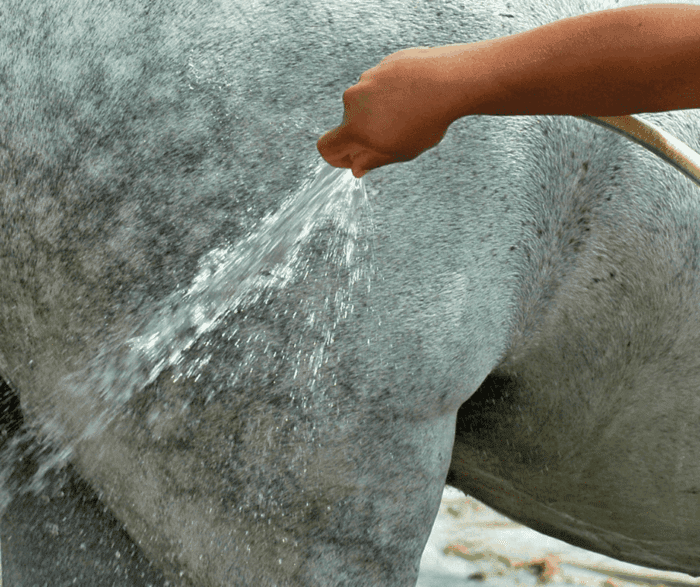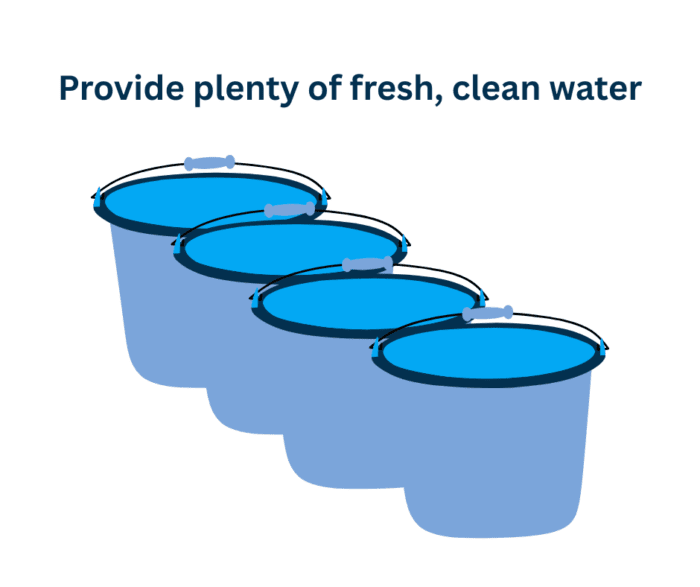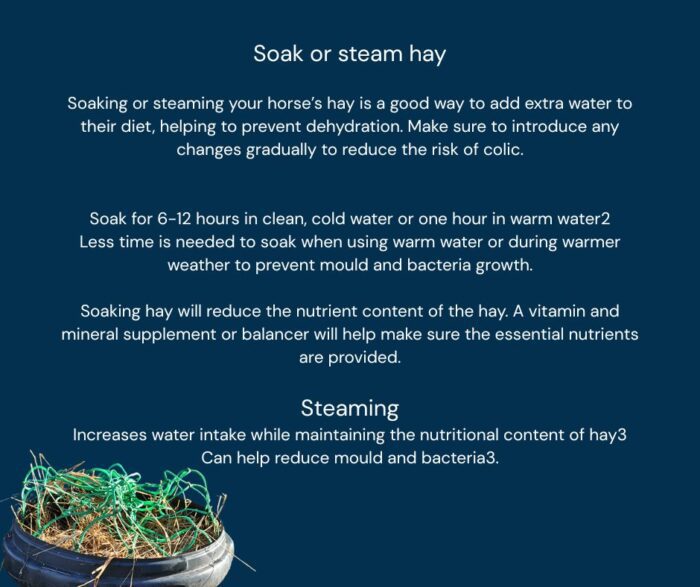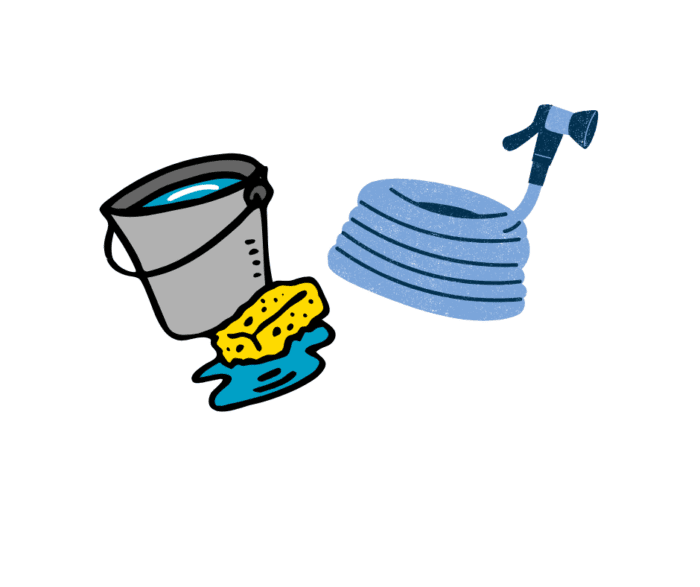As summer temperatures climb, our Horse Insurance Team share their top tips to help keep your horse or pony happy and healthy during hot weather.

- Hydration: Offer Plenty of Fresh Water
In hot weather, a horse can drink up to 50-70 litres or around four to six buckets per day1. It’s essential to always provide a constant supply of fresh, clean water.

- Exercising your horse in hot weather will also increase the amount of water they need, so it’s important keep an eye on the amount of water intake.
- Many horse owners tend to offer a mash type feed during the warmer months; this helps to replenish water intake and ensure the horse is hydrated as much as possible.
- Alongside offering a potential mash type feed, you can also encourage drinking with flavour variations such as apple juice, mint, or freezing fruit inside ice blocks can entice horses to drink more. (Source bluecross.org.uk)
- It’s important that during the hot weather, water troughs are cleaned weekly to help stop water from going stale or growing algae too quickly.
- Water plays a vital role in your horse’s digestive system, where it is constantly secreted into and reabsorbed from the gut. Inadequate hydration can disrupt this process, affecting how food moves through the digestive tract. This can increase the risk of impaction colic, a condition where a firm mass of feed material becomes lodged in the intestine, causing a blockage.
Adding Moisture to Your Horse’s Diet: Soaking and Steaming Hay
Soaking or steaming hay is an effective way to increase your horse’s water intake and help prevent dehydration. Always introduce changes gradually to minimise the risk of colic.
Soaking Hay
- Soak hay for 6–12 hours in clean, cold water or about 1 hour in warm water2.
- In warmer weather or when using warm water, shorter soaking times help reduce the risk of mould and bacterial growth.
Note: Soaking hay can lower its nutrient content. To ensure your horse still receives essential vitamins and minerals, consider adding a vitamin and mineral supplement or balancer to their diet.
Steaming Hay
- Steaming helps increase water intake while preserving more of the hay’s nutritional value3.
- It also helps reduce mould and bacteria, making hay safer for horses with respiratory sensitivities or allergies.

2. Offer Shade and Shelter
- Continuous access to shade, whether under trees or in shelters is essential to help horses escape the hot midday sun.
- Ensure any stables or shelters have good ventilation to maintain airflow and prevent overheating.
3. Manage Exercise and Travel
- Avoid intense exercise or travelling your horse in the heat. Try to ride your horse in the early morning or later in the evening when temperatures have dropped.
- If travel is unavoidable, ensure trailer or horsebox is well-ventilated and fresh water is offered often.
- Ensure to keep journey times short and only travel if is it really necessary.
4. Cooling Techniques
- After riding or exercising, make sure your horse is properly cooled down and use a hose or sponge down with water and a bucket to help remove sweat and cool down the horse.
- Read more about how to cool a horse down here.

5. Replace Salts and Electrolytes
- Horses lose significant salt through sweat; many horse owners offer a salt lick or electrolytes.
- If you are mixing electrolytes into water, always ensure another bucket of fresh water is available, so they don't drink less due to taste aversion.
6. Protect Against Sunburn & Flies
- Horses with any pink areas are particularly prone to sunburn. Make sure to apply horse-specific sun cream or children’s sunblock on these areas. However, please test a small area first to make sure your horse is not allergic.
- Keep flies, midges, and other insects at bay with repellent sprays and UV-protected fly masks
- If your horse shows signs of sunburn, move them out of the sun immediately and gently cool the affected area with water. Soothing, hydrating creams can help support healing. Ask your vet for advice on suitable products.
- If the sunburned skin becomes crusty or starts to ooze, contact your vet straight away, as this may indicate a more serious issue requiring immediate vet attention.
7. Recognise & Respond to Heat Stress
Watch for early signs of your horse overheating:
Dehydration
Dehydration can occur when a horse loses more water (for example lost in sweat, breath, urine and droppings) than it takes in. Signs of dehydration include2:
- Dark urine
- Reduced urination
- Very dry droppings
- Reduced amount of droppings
- Higher heart rate than normal
- Lethargy and/or depression
- Dry skin and mouth with thick saliva
- Dull eyes
- Longer capillary refill time – the time taken for gums to regain their healthy pink colour after pressure has been applied
- Gums that are dark in colour – become redder rather than the healthy pink.
If you suspect your horse is suffering from dehydration, consult your vet immediately.
Heat Exhaustion and Heat Stroke
Heat exhaustion is a serious condition and can occur if the horse is exposed/exercised in very hot or humid conditions for long periods and is often also suffering from dehydration. Signs of heat exhaustion may include the signs of dehydration above and potentially:
- Fast, shallow breathing (panting).
- Nostril flaring.
- Increased rectal temperature, that doesn’t, or very slowly, returns to normal after a period of rest. The normal range is between 37.5-38.5°C.
- An irregular heartbeat.
- Decreased appetite and thirst.
- Slow recovery after exercise.
- Muscle spasms.
- Reduced performance.
- Lethargy.
- Dark urine/reduced urination.
- Dark mucous membranes (gums).
- Synchronous Diaphragmatic Flutter (SDF), also known as “Thumps”, is when the horse’s heartbeat and diaphragm synchronise and causes the horse to show hiccup-like contractions, often with a thumping sound.
If your horse is showing signs of heat-related illness, contact your vet immediately, move them into the shade and provide water to encourage them to drink. Start to cool the horse by continuously applying cold water all over their body, without scraping, until help arrives. It may take 10-15 minutes before you start to see an improvement in the horse’s condition.
If not quickly and carefully managed, a horse suffering from heat exhaustion can progress to develop life-threatening heat stroke, although this can sometimes appear suddenly without warning. Horses suffering from heat stroke can be very challenging and dangerous to manage as their behaviour can become aggressive and some signs may appear neurological, for example losing perception of where they are, with no regard for their handler. The horse may also become unsteady on their feet and/or collapse. If not treated quickly and effectively it can cause damage to the kidneys, heart, lungs, brain or muscles, and in some cases can be fatal1.
References
- Nyman, S. et al (2002) Water intake and fluid shifts in horses: effects of hydration status during two exercise tests - PubMed (nih.gov)
- Rendle, D et al. (2018) Equine obesity: current perspectives. UK Vet Equine. Vol 2.
- Moore-Colyer, M.J., et al (2016). The effect of steaming and soaking on the respirable particle, bacteria, mould, and nutrient content in hay for horses. Journal of Equine Veterinary Science, 39, pp.62-68.
Information from British Horse Society and World Horse Welfare.